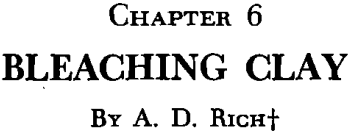Table of Contents
The term “bleaching clay” or “bleaching earth,” as used in the oil industries, refers to clays that in their natural state, or after chemical or physical activation, have the capacity for adsorbing coloring matter from oil. There are three common types of bleaching clays: fuller’s earth, activated clays, and activated bauxite.
Composition
The raw clays from which both fuller’s earth and acid-activated clays are prepared are composed of hydrous aluminum silicates containing varying quantities of magnesium, iron, calcium and other elements. These raw materials are usually nonswelling bentonites derived from volcanic ash or lava by weathering and hydrothermal chemical reactions. The bentonites have as their chief mineral constituent montmorillonite, which has the ideal formula Al2Si4O10(OH)2nH2O. The underlying reasons are not fully known for the natural activity of the fuller’s earth type of clay and its usual failure to further activate with mineral acid in contrast to the natural inactivity of the activable type of clay. However, it may be said that the bentonites that are responsive to the acid-activation treatment generally have not undergone any drastic metamorphism.
Properties
Properties of bleaching earths from different parts of the country, or even in different parts of one deposit, frequently vary over a considerable range, therefore it is necessary to generalize in discussing this subject.
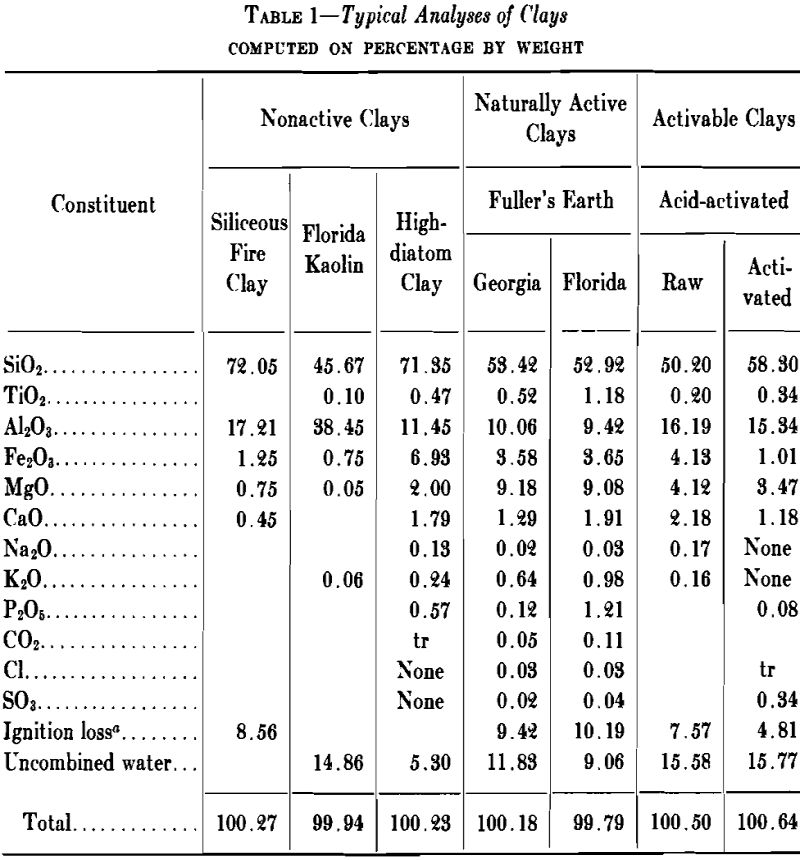
The apparent density of fuller’s earths is somewhat lower usually than that of the acid-activated or ordinary kaolinite clays. Fuller’s earth from Georgia and Florida usually weighs 30 to 40 lb per cu ft when processed, compared with 40 to 50 lb per cu ft for the acid-activated clays. Minerals found present in some fuller’s earths include attapulgite, illite, nontronite, and kaolinite, in addition to montmorillonite.
Theories of Behavior of Bleaching Clays
The theory of the action of bleaching clays in decolorizing oils is highly involved and the underlying reasons for the phenomenon are not completely known. Suffice it to state here that the action is not a straining or filtering action but a selective adsorption of the color bodies and other impurities. The adsorbed color bodies and impurities are strongly held within the clay structure and can be removed only by drastic treatment. This indicates that the bleaching clays operate mainly by chemical adsorption. The literature should be consulted for a thorough investigation of the subject.
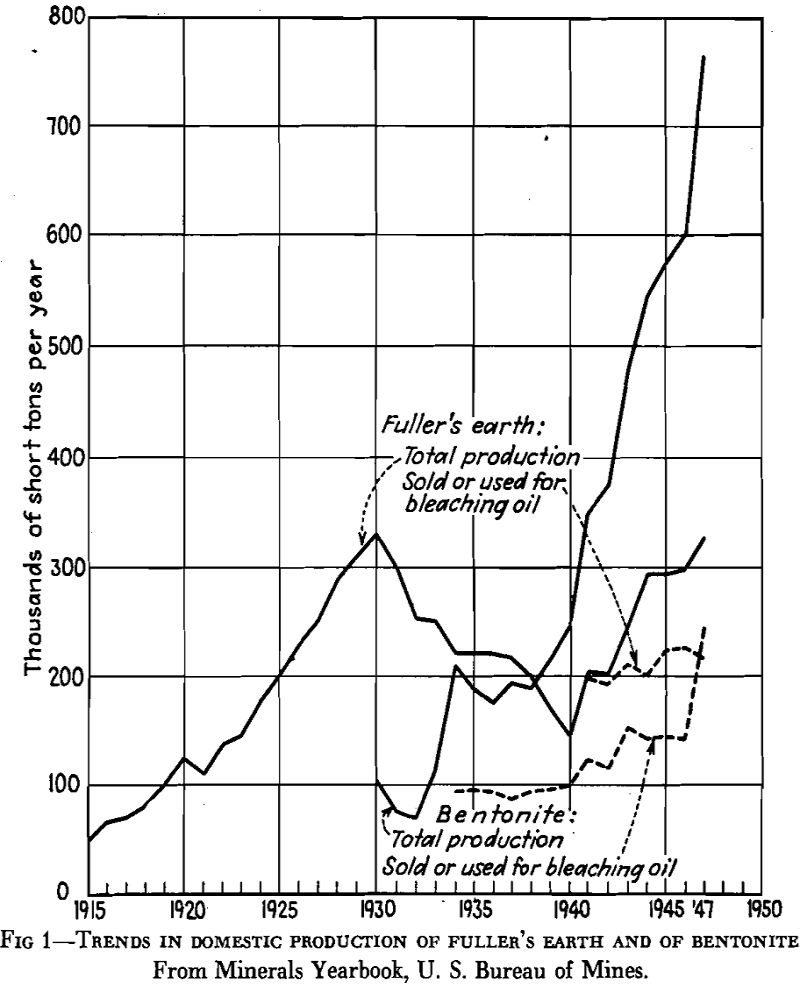
Prospecting, Exploration and Mining
Prospecting and Exploration—The United States Geological Survey and various state geological surveys have made a rather extensive study of bleaching earths in the United States and various publications give details as to the location and nature of deposits covered in these studies. The relatively low value of bleaching earth makes it of little interest to the individual prospector. Most of the large companies do this work as needed. Many samples are received by these companies from landowners, and if the tests show promising results the deposits are inspected and samples obtained by opencut methods or by use of hand core drills. Since the quantity of naturally active and activable clays in the United States is far in excess of any conceivable demand, prospecting and exploration are limited to properties for which location and mining conditions are particularly favorable.
Mining Methods—Mining of bleaching earths for the most part is by the opencut method. The overburden, ranging from 5 to 50 ft in depth, is removed either by steam shovel or dragline to within approximately one foot of the top of the clay. The remaining foot of overburden is removed carefully by hand or mechanical means. It is the usual practice to lay out the area carefully before beginning work, so as to evaluate fully the quality and amount of material to be mined. Whenever possible, mining is done in dry weather, in order to avoid excess handling of moisture.
Preparation for Market
Fuller’s Earth
When the bleaching earth is to be used in the natural state without activation or granulation, preparation for market is comparatively simple. It is necessary only to pass the raw lump clay through a crusher, dry the crushed clay by means of a gas, wood, or oil-fired rotary drier, and finally to grind the dried clay to the desired size. Dust losses are insignificant because little money is spent on the material. It is impor-
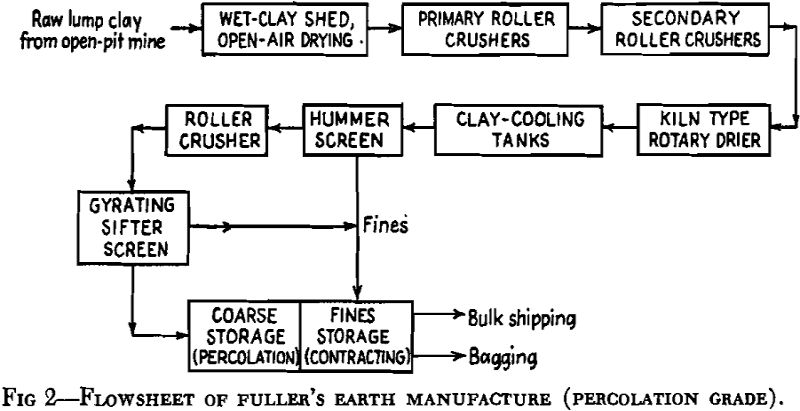
tant to maintain careful technical control of temperature and time in the drying operation, because the clay can be injured greatly by incorrect handling. Experience has shown that a free moisture content of from 8 to 10 pct gives the greatest efficiency for natural clays of the contact type. This corresponds approximately to a total volatile content of 15 pct. The preparation of granular fuller’s earth is somewhat more complicated.
Activated Clay
The manufacture of an activated clay is more complicated than the manufacture of the granular fuller’s earth. There are seven important steps in the process: (1) preparing the raw clay for charging to treaters or reaction vessels; (2) activating; (3) washing out impurities; (4) dewatering mechanically; (5) drying; (6) grinding to proper mesh size; (7) packaging.
The raw clay for charging to treaters may be prepared by either wet or dry method. When the wet method is employed water is added to the raw clay, which is already high in moisture, until it forms a slurry or thick slime, which is then conveyed to treaters by pumps or gravity. When the so-called dry method is employed, much of the free moisture is removed from the clay by a predrier. The dried clay is then usually conveyed by belts to a mixer, where water is added in order to make a slurry as it enters the treaters. Different methods are employed, depending upon the nature of the clay. Sometimes, instead of using ordinary water for making a slurry, a “sour” water or return liquor from the washing system is used. The clay and water, or liquor, are accurately measured before going to the treaters.
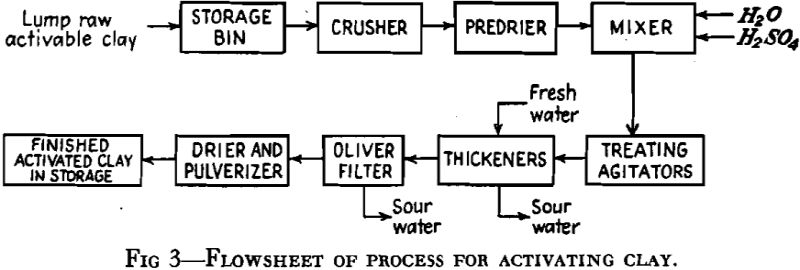
Tests and Specifications
The specifications for bleaching earths depend largely on the nature of the work to be done. For refining vegetable, animal and mineral oils by the contacting method, a finely pulverized clay is used, having a mesh of at least 50 pct through 200 and generally from 85 to 95 pct through 200. The limiting factors on fineness are filter rate, or the speed with which the oil can be separated from the clay cake after contacting, and oil retention. If too much impalpable powder is present, the filter rate may be retarded to a point unsuitable for use in refining and the oil retention may be so high that losses of oil in the press cake may become excessive.
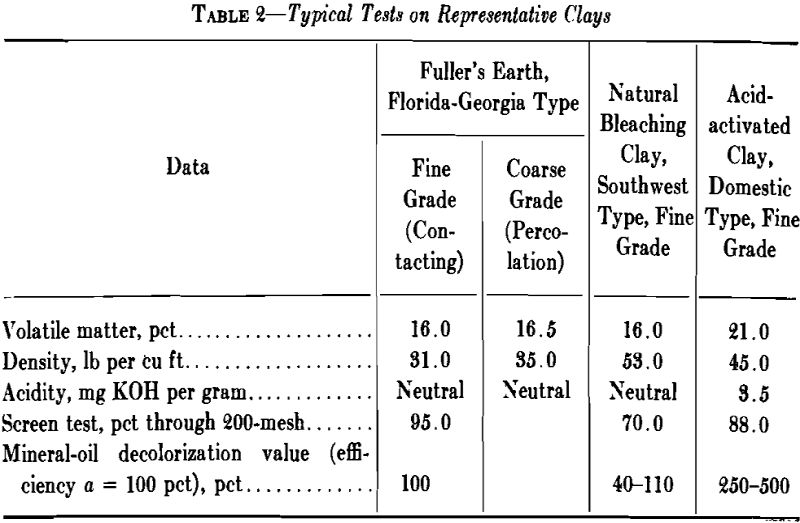
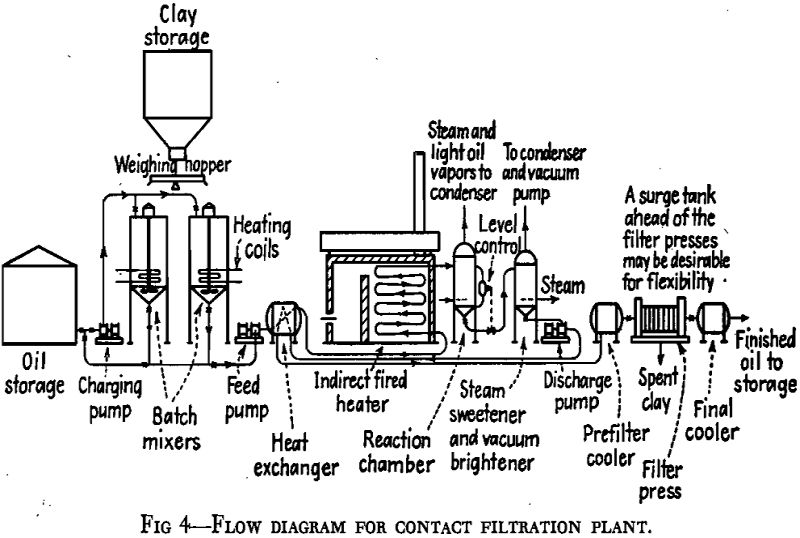
Marketing and Uses
The principal object of applying bleaching earths is to remove color but there are increasingly important uses in all fields of refining that do not involve removal of color; for instance, in treatment of naphtha, reduction of the amount of gum and stability are more important factors. In refining of lubricating oil, improved sludge content, carbon content, oxidation test, acidity, emulsion test, viscosity index, and other factors, are often more important, and in the vegetable-oil field, stabilization and removal of residual soap, gums, odor, and taste are often the more important factors.
